
The Wresume site
Get your free resume templates

Get your free resume templates

Tokyo, State Zip
(123) 456-7890 • yourmail@gmail.com
linkedin.com/in/yourname
WORK EXPERIENCE
Company 4 , Location
Job Title (MM/YYYY)-Present
This is where you write about your experience. Do not simply list your day-to-day job duties. Work in resume keywords that are most relevant to the job for which you’re applying. Try replacing some of your duties with measurable results and accomplishments rather than duties. Remember, “duties tell, accomplishments sell.” To create a strong measurable result, try this format: [Action verb] [brief explanation of accomplishment] resulting in [quantifiable outcome. Using %, $, etc. will draw the eye and make an impact]. For example: “Responded to an average of 203 customer service emails per week, improving response time by 74% and customer satisfaction by 31% between 2016 to 2017.”
Company 3 , Location
Job Title (MM/YYYY)-(MM/YYYY)
Keep your sentences short and to the point. This will make it easier for a recruiter or hiring manager to read or skim. Use your limited space to focus on things are that most relevant to the new job, rather than going into every detail about the responsibilities that took up most of your time. Tailor your resume to the job description.
Company 2 , Location
Job Title (MM/YYYY)-(MM/YYYY)
It’s OK to leave positions off your resume if they aren’t relevant to the job you’re pursuing. Unless the experience is crucial, you can also go into fewer details on older positions.
Company 1 , Location
Job Title (MM/YYYY)-(MM/YYYY)
Don’t worry about having the same amount of information for each job. Spend more words on the most transferable skills and experience.
EDUCATION
Degree, Graduation Year (YYYY)
College Name, Location

Your Name Rio, State Zip • (123) 456-7890
yourmail@gmail.com • linkedin.com/in/yourname
Skills
Skill 1 Skill 2 Skill 3 Skill 4
Skill 5 Skill 6 Skill 7 Skill 8
Experience
Company 4, Location
Job Title , MM/YYYY-Present
Tailor your experience sections to the job description. Don’t use up too much of your space detailing daily duties that aren’t relevant to the job for which you’re applying. Study the job listing to figure out what’s most important to the hiring manager. Use important resume keywords and accomplishments that speak to your ability to execute.
Key technologies used: Software/Skill 1, Software/Skill 2, Software/Skill 3, Software/Skill 4
Company 3, Location
Job Title , MM/YYYY-Present
Work the hard skills and keywords found in the job description right into your resume. That said, simply listing the keywords in these dedicated skills sections is not enough. Recruiters want to see context that proves that you actually possess the skill. For example, if you mention a piece of software like Microsoft Excel, Adobe Photoshop, or AutoCAD, mention the types of projects it was used for.
Key technologies used: Software/Skill 1, Software/Skill 2, Software/Skill 3, Software/Skill 4
Company 2, Location
Job Title , MM/YYYY-Present
Recruiters like to be able to get an idea of why you move from company to company. Demonstrating your increasing impact and responsibility from job to job shows the recruiter that you’re capable of taking on more and more and gives them an idea of where your career is heading.
Company 1, Location
Job Title , MM/YYYY-Present
You don’t need to include every job you’ve ever had on your resume. Stick to the jobs that are most relevant and demonstrate your career trajectory. For example, if you are a Project Manager, you probably don’t need to mention the supermarket job you had as a teenager or the bartending job your maintain on the weekends.
Education
Degree, Graduation Year (YYYY), College Name, Location
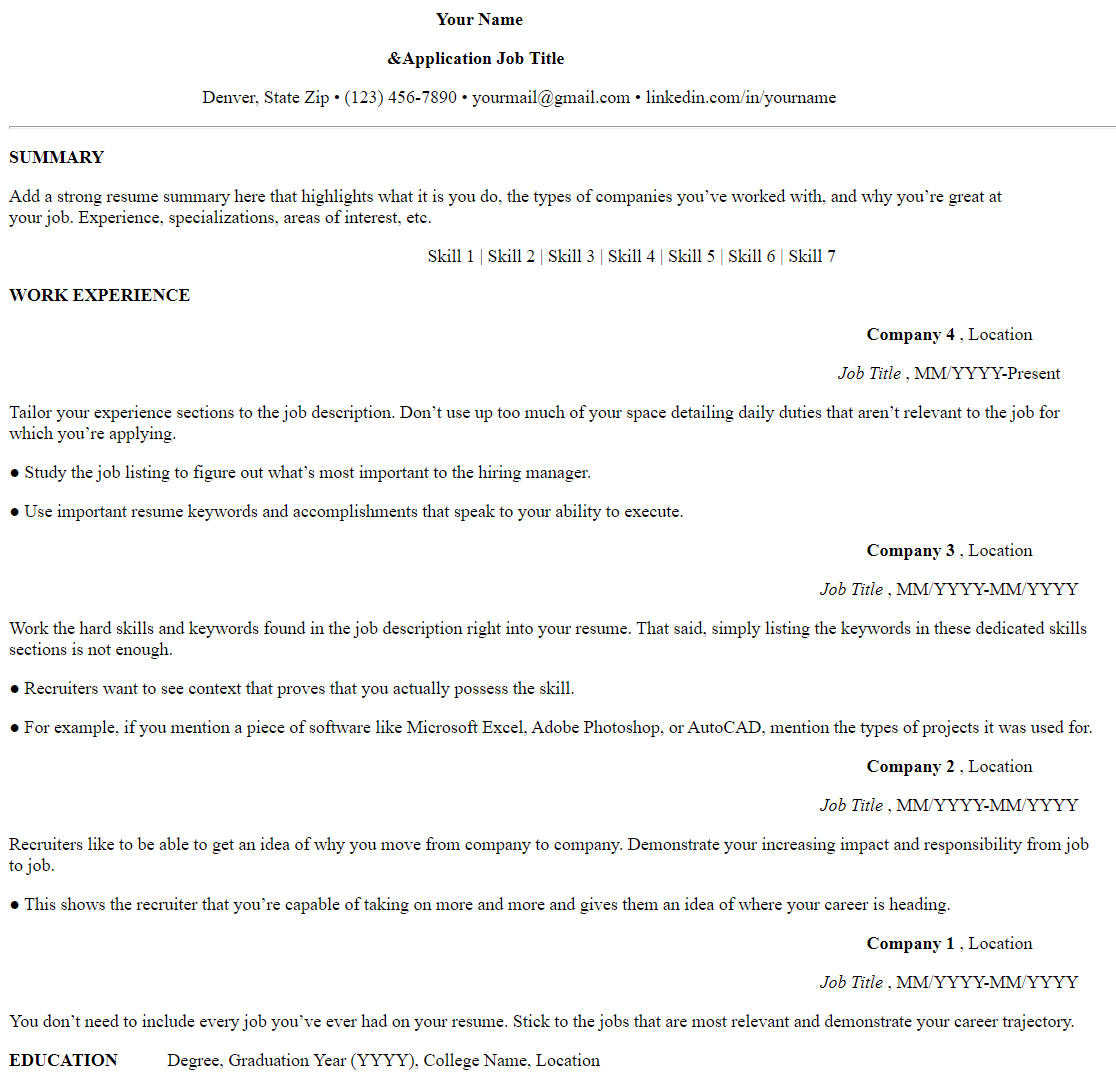
Your Name
Application Job Title
Denver, State Zip • (123) 456-7890 • yourmail@gmail.com • linkedin.com/in/yourname
SUMMARY
Add a strong resume summary here that highlights what it is you do, the types of companies you’ve worked with, and why you’re great at your job. Experience, specializations, areas of interest, etc.
Key skills include:
Skill 1 | Skill 2 | Skill 3 | Skill 4 | Skill 5 | Skill 6 | Skill 7
WORK EXPERIENCE
Company 4 , Location
Job Title , MM/YYYY-Present
Tailor your experience sections to the job description. Don’t use up too much of your space detailing daily duties that aren’t relevant to the job for which you’re applying.
● Study the job listing to figure out what’s most important to the hiring manager.
● Use important resume keywords and accomplishments that speak to your ability to execute.
Company 3 , Location
Job Title , MM/YYYY-MM/YYYY
Work the hard skills and keywords found in the job description right into your resume. That said, simply listing the keywords in these dedicated skills sections is not enough.
● Recruiters want to see context that proves that you actually possess the skill.
● For example, if you mention a piece of software like Microsoft Excel, Adobe Photoshop, or AutoCAD, mention the types of projects it was used for.
Company 2 , Location
Job Title , MM/YYYY-MM/YYYY
Recruiters like to be able to get an idea of why you move from company to company. Demonstrate your increasing impact and responsibility from job to job.
● This shows the recruiter that you’re capable of taking on more and more and gives them an idea of where your career is heading.
Company 1 , Location
Job Title , MM/YYYY-MM/YYYY
You don’t need to include every job you’ve ever had on your resume. Stick to the jobs that are most relevant and demonstrate your career trajectory. For example, if you are a Project Manager, you probably don’t need to mention the supermarket job you had as a teenager.
EDUCATION
Degree, Graduation Year (YYYY), College Name, Location
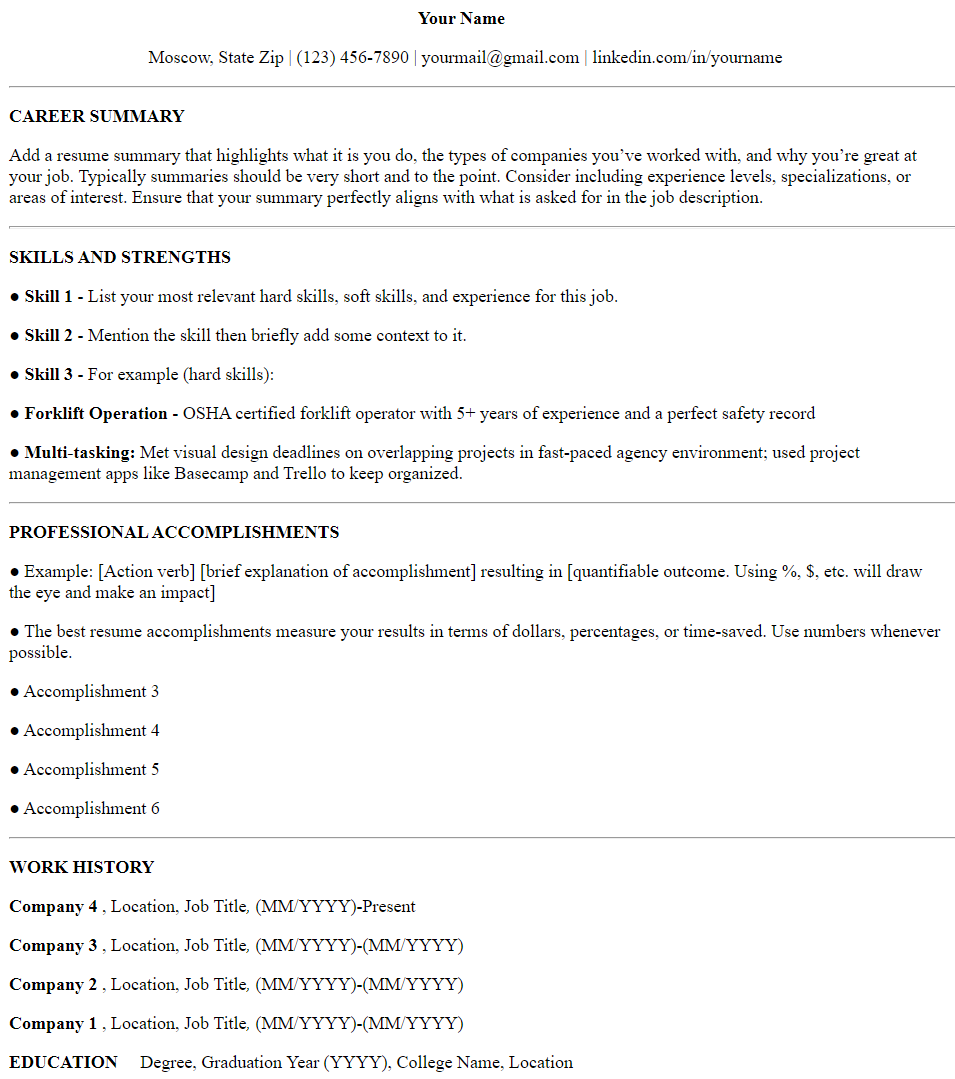
Your Name
Moscow, State Zip | (123) 456-7890 | yourmail@gmail.com | linkedin.com/in/yourname
CAREER SUMMARY
Add a resume summary that highlights what it is you do, the types of companies you’ve worked with, and why you’re great at your job. Typically summaries should be very short and to the point, but you can go a little long in the functional resume format. Consider including experience levels, specializations, or areas of interest. Ensure that your summary perfectly aligns with what is asked for in the job description.
SKILLS AND STRENGTHS
● Skill 1 - List your most relevant hard skills, soft skills, and experience for this job.
● Skill 2 - Mention the skill then briefly add some context to it.
● Skill 3 - For example (hard skills):
● Forklift Operation - OSHA certified forklift operator with 5+ years of experience and a perfect safety record
● Skill 5 - Another example (soft skills):
● Multi-tasking: Met visual design deadlines on overlapping projects in fast-paced agency environment; used project management apps like Basecamp and Trello to keep organized.
PROFESSIONAL ACCOMPLISHMENTS
● Example: [Action verb] [brief explanation of accomplishment] resulting in [quantifiable outcome. Using %, $, etc. will draw the eye and make an impact]
● The best resume accomplishments measure your results in terms of dollars, percentages, or time-saved. Use numbers whenever possible.
● Accomplishment 3
● Accomplishment 4
● Accomplishment 5
● Accomplishment 6
WORK HISTORY
Company 4 , Location, Job Title, (MM/YYYY)-Present
Company 3 , Location, Job Title, (MM/YYYY)-(MM/YYYY)
Company 2 , Location, Job Title, (MM/YYYY)-(MM/YYYY)
Company 1 , Location, Job Title, (MM/YYYY)-(MM/YYYY)
EDUCATION
Degree, Graduation Year (YYYY), College Name, Location
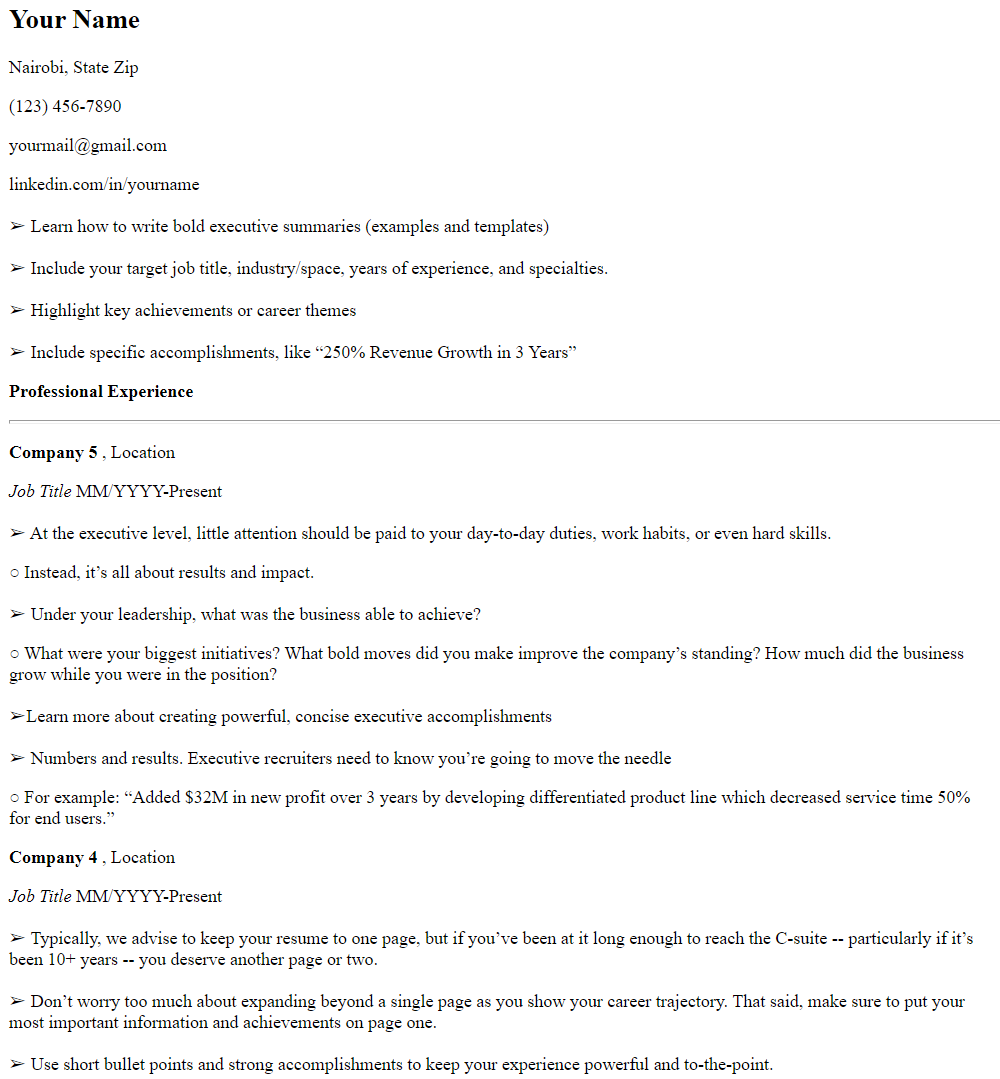
Your Name
Nairobi, State Zip
(123) 456-7890
yourmail@gmail.com
linkedin.com/in/yourname
➢ Learn how to write bold executive summaries (examples and templates)
➢ Include your target job title, industry/space, years of experience, and specialties.
➢ Highlight key achievements or career themes
➢ Include specific accomplishments, like “250% Revenue Growth in 3 Years”
Professional Experience
Company 7 , Location
Job Title MM/YYYY-Present
➢ At the executive level, little attention should be paid to your day-to-day duties, work habits, or even hard skills.
○ Instead, it’s all about results and impact.
➢ Under your leadership, what was the business able to achieve?
○ What were your biggest initiatives? What bold moves did you make improve the company’s standing? How much did the business grow while you were in the position?
➢Learn more about creating powerful, concise executive accomplishments
➢ Numbers and results. Executive recruiters need to know you’re going to move the needle
○ For example: “Added $32M in new profit over 3 years by developing differentiated product line which decreased service time 50% for end users.”
Company 6 , Location
Job Title MM/YYYY-Present
➢ When applying for executive positions, you can’t lean on your hard skills as much as you did earlier in your career. Executive soft skills take on greater significance.
○ Unfortunately, you can’t just say you have leadership and expect executive recruiters to believe you. You have to find a way to prove it. For example:
➢ Leadership: Ask yourself, what situations benefited the most from your timely leadership?
➢ Vision: When you mention your big ideas, initiatives, and accomplishments, demonstrate your vision by including the why and placing them in context of the bigger picture.
➢ Entrepreneurial: Think back to any pet projects you nurtured, departments you grew, or calculated risks that paid off big.
➢ I nnovation: Compile the best examples and stories from your past experience in which you changed operating procedure, streamlined processes, consolidated systems, or mined a previously untapped sector of the market.
Company 5 , Location
Job Title MM/YYYY-Present
➢ Typically, we advise to keep your resume to one page, but if you’ve been at it long enough to reach the C-suite -- particularly if it’s been 10+ years -- you deserve another page or two.
➢ Don’t worry too much about expanding beyond a single page as you show your career trajectory. That said, make sure to put your most important information and achievements on page one.
➢ Use short bullet points and strong accomplishments to keep your experience powerful and to-the-point.
Company 3 , Location
Job Title MM/YYYY-Present
➢ Your executive brand is important to executive recruiters. “I don’t care if it goes back 15 or 30 years,” an executive recruiter told Jobscan . “I just want to see that the resume is promoting a highly competent, proven executive who knows what they’re best at, where they want to go, and what they really want to do next in their career.”
➢ Find opportunities to show not only the end results, but how you identify opportunities and achieve results
➢ If possible, communicate your business values. Give the recruiter an idea of what you’ll want to accomplish first at this new job based on what you’re sharing about your previous jobs.
Company 2 , Location
Job Title MM/YYYY-Present
➢ As you get further back in your career to your roles as a manager or individual contributor, start to pepper in more of your hard skills and domain knowledge.
➢ Executive recruiters will like to gain an understanding of your career foundation.
Company 1 , Location
Job Title MM/YYYY-Present
➢ “What have you done for me lately?” You don’t need to include your entire career on your resume. If something is 15 or more years old, think hard about whether it adds to your candidacy or not, especially if age discrimination is a concern.
Education
Degree, Graduation Year (YYYY - Optional)
College Name, Location
List additional certifications or relevant leadership/management trainings you’ve received
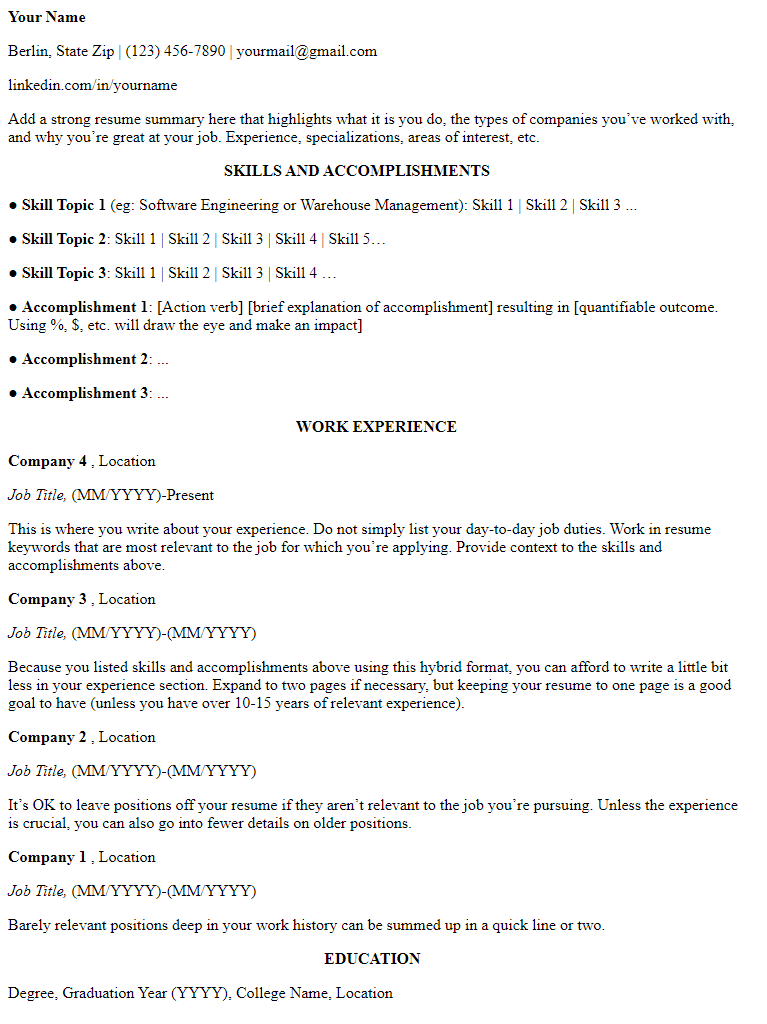
Your Name
Berlin, State Zip | (123) 456-7890 | yourmail@gmail.com
linkedin.com/in/yourname
Add a strong resume summary here that highlights what it is you do, the types of companies you’ve worked with, and why you’re great at your job. Experience, specializations, areas of interest, etc.
SKILLS AND ACCOMPLISHMENTS
● Skill Topic 1 (eg: Software Engineering or Warehouse Management): Skill 1 | Skill 2 | Skill 3 ...
● Skill Topic 2: Skill 1 | Skill 2 | Skill 3 | Skill 4 | Skill 5…
● Skill Topic 3: Skill 1 | Skill 2 | Skill 3 | Skill 4 …
● Accomplishment 1: [Action verb] [brief explanation of accomplishment] resulting in [quantifiable outcome. Using %, $, etc. will draw the eye and make an impact]
● Accomplishment 2: ...
● Accomplishment 3: ...
WORK EXPERIENCE
Company 4 , Location
Job Title, (MM/YYYY)-Present
This is where you write about your experience. Do not simply list your day-to-day job duties. Work in resume keywords that are most relevant to the job for which you’re applying. Provide context to the skills and accomplishments above.
Company 3 , Location
Job Title, (MM/YYYY)-(MM/YYYY)
Because you listed skills and accomplishments above using this hybrid format, you can afford to write a little bit less in your experience section. Expand to two pages if necessary, but keeping your resume to one page is a good goal to have (unless you have over 10-15 years of relevant experience).
Company 2 , Location
Job Title, (MM/YYYY)-(MM/YYYY)
It’s OK to leave positions off your resume if they aren’t relevant to the job you’re pursuing. Unless the experience is crucial, you can also go into fewer details on older positions.
Company 1 , Location
Job Title, (MM/YYYY)-(MM/YYYY)
Barely relevant positions deep in your work history can be summed up in a quick line or two.
EDUCATION
Degree, Graduation Year (YYYY), College Name, Location
One can use it according to their position.
Contact Information
[Your Name]
[Your Job Title]
[Email Address]
[Phone Number]
[LinkedIn]
[Optional: Personal Website, Twitter, Other Relevant Links]
Resume Summary Statement
Dependable/Detail-oriented/Creative[Your Job Title] with [X] years of experience in [Your Industry/Niche]. Helped [increase revenue/cut costs/train employees/other achievements] by [X]%. Looking to join [Company Name] to ensure[highest customer happiness scores/a steady boost in ROI/prompt project delivery/other metrics and KPIs you hope to deliver for the prospective employer].
Work Experience/Job Description
[Your Job Title]
[Company Name]
[2012–2019]
[Your Previous Job Title]
[Previous Company Name]
[2008–2012]
Education
[BA/MA in Your Major]
[University Name]
[Graduation Year]
Skills
[Skill #1: Advanced]
[Skill #2: Advanced]
[Skill #3: Basic]
[Certifications]
Additional Resume Sections
[Volunteer Experience]
[Conference Participation]
[Hobbies and Interests]
(First Impression Is The Last Impression)
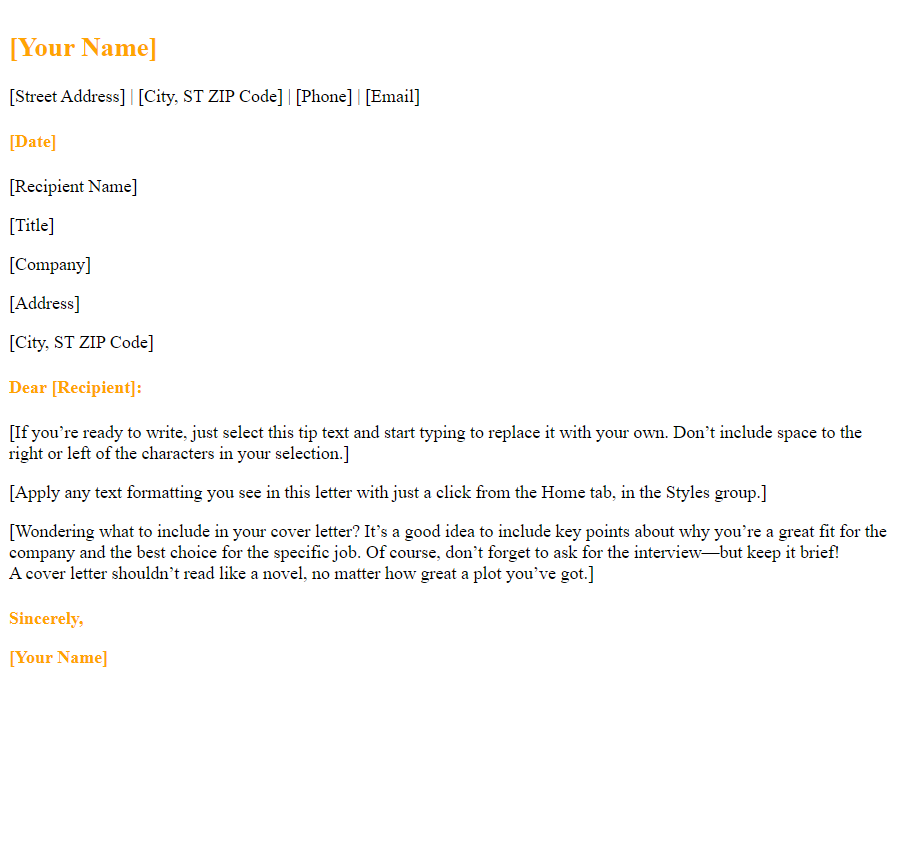
[Street Address] | [City, ST ZIP Code] | [Phone] | [Email]
[Recipient Name]
[Title]
[Company]
[Address]
[City, ST ZIP Code]
[If you’re ready to write, just select this tip text and start typing to replace it with your own. Don’t include space to the right or left of the characters in your selection.]
[Apply any text formatting you see in this letter with just a click from the Home tab, in the Styles group.]
[Wondering what to include in your cover letter? It’s a good idea to include key points about why you’re a great fit for the company and the best choice for the specific job. Of course, don’t forget to ask for the interview—but keep it brief! A cover letter shouldn’t read like a novel, no matter how great a plot you’ve got.]

Street Address | City, ST ZIP Code | Phone | Email
Recipient Name
Title
Company
Address
City, ST ZIP Code
If you’re ready to write, just select this tip text and start typing to
replace it with your own. Don’t include space to the
right or left of the
characters in your selection.
Apply any text formatting you see in this letter with just a click from the Home tab, in the Styles group.
Wondering what to include in your cover letter? It’s a good idea to
include key points about why you’re a great fit for the
company and the
best choice for the specific job. Of course, don’t forget to ask for the
interview—but keep it brief!
A cover letter shouldn’t read like a novel, no
matter how great a plot you’ve got.
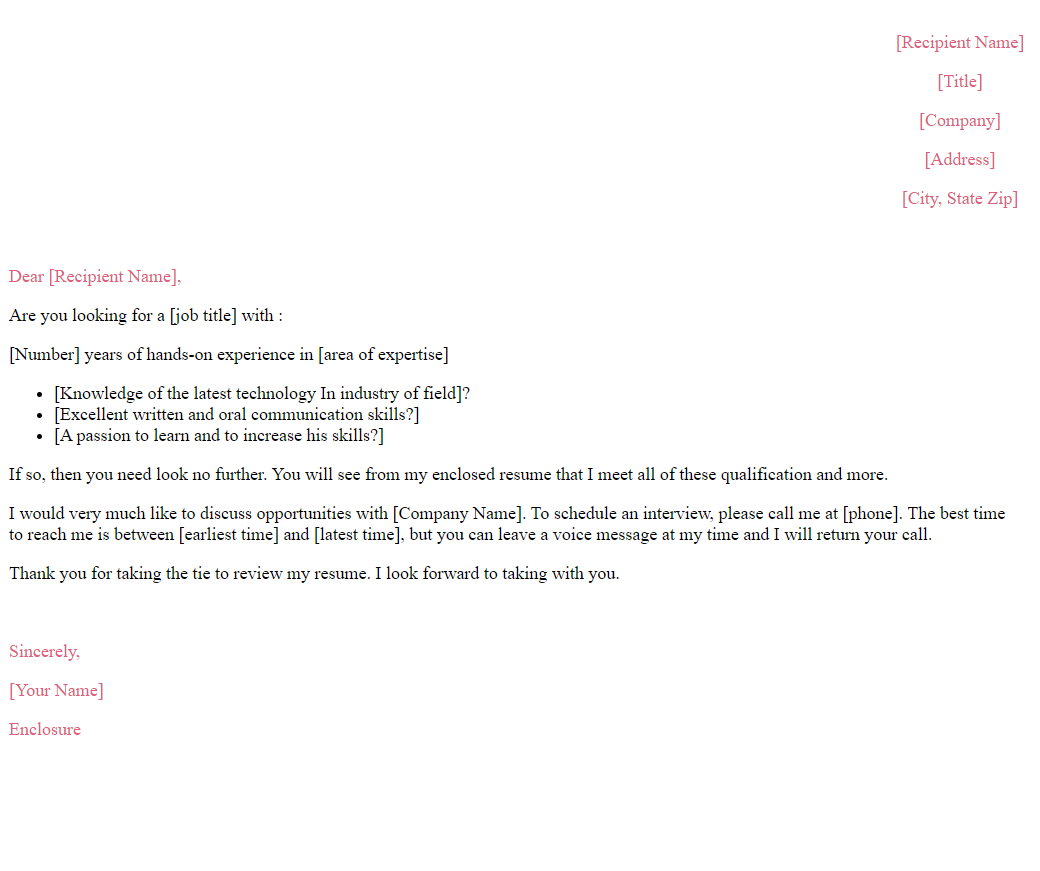
[Recipient Name]
[Title]
[Company]
[Address]
[City, State Zip]
Dear [Recipient Name],
Are you looking for a [job title] with :
[Number] years of hands-on experience in [area of expertise]
If so, then you need look no further. You will see from my enclosed resume that I meet all of these qualification and more.
I would very much like to discuss opportunities with [Company Name]. To
schedule an interview, please call me at [phone]. The best time
to reach me
is between [earliest time] and [latest time], but you can leave a voice
message at my time and I will return your call.
Thank you for taking the tie to review my resume. I look forward to taking with you.
Sincerely,
[Your Name]
Enclosure
A cover letter is more than just a formality or courtesy – it is an opportunity to impress. Research suggests that employers favor resumes that are accompanied by a cover letter, making it a critical component of your job-search strategy.
A well-written cover letter is an opportunity to show the reader your:
Failure doesn't mean you are a failure it just means you haven't succeeded yet.
Robert H. Schuller